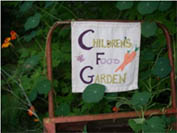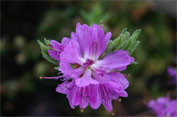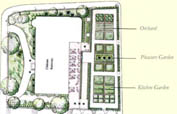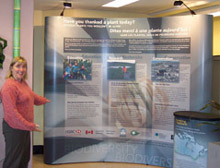1. Editorial
Dear readers,
The current edition of the Canadian Botanical Gardens Educator’s Network
Newsletter is pleased to announce a new venture. As of the next edition, we
will join forces with the Canadian Botanical Conservation Network (CBCN) Newsletter.
This partnership will allow for a strengthened network and will serve to widen
the horizon that we offer our readers. As such, readers will be able to find
subject matter relating to plant conservation and biodiversity education and
will also benefit from information more scientific in nature from the CBCN Newsletters.
We believe that this change will serve as a benefit to all.
At the unveiling of this hybrid newsletter, we will be highlighting the International
Day for Biological Diversity (May 22nd, 2007). As this year’s theme is
Biological Diversity and Climate Change, we will endeavour to maintain the same
focus for our newsletter. We thank you for your loyalty, and we welcome your
submissions (articles, event announcements, etc).
Yours sincerely,
Yann Vergriete
yannvergriete@fastmail.fm
2. Shoots with Roots
 Educators from Canadian gardens and programs of all sizes are encouraged to
contribute activities to the National Outreach Resource Guide for Plant Conservation
and Biodiversity Education, to be launched in the end of 2007. The Shoots with
Roots program at Milner Gardens & Woodland is an example of a small and
young program that has made great impact with its outreach program. Their outreach
activity is routinely offered at community events and garden shows, and is also
taken to schools when possible.
Educators from Canadian gardens and programs of all sizes are encouraged to
contribute activities to the National Outreach Resource Guide for Plant Conservation
and Biodiversity Education, to be launched in the end of 2007. The Shoots with
Roots program at Milner Gardens & Woodland is an example of a small and
young program that has made great impact with its outreach program. Their outreach
activity is routinely offered at community events and garden shows, and is also
taken to schools when possible.
Recently there was a narrow window of 3 days to take the activity to local
classrooms. In 9 hours of student interaction time, 471 students from 21 classes
(3 schools) were involved in a hands-on educational opportunity. As students
make newspaper pots and plant organic vegetable and native plant seeds they
learn about plant systems, processes and values. They also make ‘germination
windows’ to watch as they care for the growing plants in their classroom.
When ready, the seedlings are used on the school grounds and planted by Shoots
with Roots students in the Children’s Food Garden at Milner.
More information on this activity and many more will be offered in the National
Outreach Resource Guide for Plant Conservation and Biodiversity Education. This
will be a valuable resource for all educators. Please share details of your
program activities by contacting Yann: yannvergriete@fastmail.fm
Milner Gardens & Woodland
Qualicum Beach, BC
For information about Milner Gardens & Woodland, please visit:
www.milnergardens.org
3. PlantWatch Nova Scotia
 One of the education and community outreach initiatives underway at Harriet
Irving Botanical Gardens is through our partnership with the national PlantWatch
program. PlantWatch is a joint venture of Nature Canada and Environment Canada's
Ecological Monitoring and Assessment Network. The purpose of PlantWatch is to
involve Canadians of all ages in the observation of our natural world and to
help scientists discover how and why plants are being affected by our changing
climate.
One of the education and community outreach initiatives underway at Harriet
Irving Botanical Gardens is through our partnership with the national PlantWatch
program. PlantWatch is a joint venture of Nature Canada and Environment Canada's
Ecological Monitoring and Assessment Network. The purpose of PlantWatch is to
involve Canadians of all ages in the observation of our natural world and to
help scientists discover how and why plants are being affected by our changing
climate.
Volunteers from all provinces and territories make up a network of ‘citizen
scientists’ who annually record flowering and leafing times of plants
in their local communities. The data from each region of Canada is sent in via
the internet or regular mail to a common database. From this data, trends can
be seen and conclusions drawn on what effect climate change is having on the
plant world.
We are very fortunate in Nova Scotia to have 23 years of historical data from
the early 1900s that we can use to compare with the data we collect today. From
1900-1923 school children under the direction of the superintendent of schools,
Dr. Alexander McKay recorded over 200 natural events annually. It is our hope
that through PlantWatch we will be able to pull kids away from their computers
and get them outside watching spring happen as they did at the turn of the century.
 Last year the first plant to watch in Nova Scotia was Populus tremuloides,
Aspen. It bloomed in Kings County on March 3rd.
Last year the first plant to watch in Nova Scotia was Populus tremuloides,
Aspen. It bloomed in Kings County on March 3rd.
Melanie Priesnitz
Conservation Horticulturist
For more information on PlantWatch Nova Scotia visit: botanicalgardens.acadiau.ca/education.html
For information on the national program visit:
www.plantwatch.ca
4. Vestiges of the Plants of Yesteryear in the Heart of the City
 Behind the Château Ramezay Museum, in the heart of Old Montreal, the
Governor’s Garden stands as a witness to the traditions of natural cultivation
and conservation. As such, the species found today are very close to the seedlings
which once sprouted in the Governor Claude de Ramezay’s actual garden
during the 18th century. In addition to the decorative flowers, grasses, fruit
trees and garden vegetables which were cultivated at the time, we can also find
the "Three Sisters" – corn seedlings that were sown with beans
and squash by the Iroquois. The beans use the corn stalk for growth support,
and the broad sheets of squash preserve moisture and prevent weeds from growing.
Behind the Château Ramezay Museum, in the heart of Old Montreal, the
Governor’s Garden stands as a witness to the traditions of natural cultivation
and conservation. As such, the species found today are very close to the seedlings
which once sprouted in the Governor Claude de Ramezay’s actual garden
during the 18th century. In addition to the decorative flowers, grasses, fruit
trees and garden vegetables which were cultivated at the time, we can also find
the "Three Sisters" – corn seedlings that were sown with beans
and squash by the Iroquois. The beans use the corn stalk for growth support,
and the broad sheets of squash preserve moisture and prevent weeds from growing.
Inside the Governor’s Garden, the methods used to combat insects, weeds
and mushrooms are ecological and respectful of the environment. No pesticides,
be it insecticide, weed-killer, or fungicide, are used. For example, in order
to protect the plants from insects, the gardener grows plants, such as chives
or hyssop, which have a repellent effect. As was the case in New France, the
current garden uses natural fertilizers, obtained through composting and incorporating
straw into the soil.
Many summer activities are planned for the Governor’s Garden. While certain
activities focus on the Garden’s historical aspects, others concentrate
on botany and celebrate the diversity of the plants. On July 14th, a handmade
soap workshop will be offered for our visitors to perfume their own soap using
flowers gathered in the Governor’s Garden. Also, on August 4th, our guests
will be able to discover the handcrafted production of vegetable dyeing. The
dyers will begin by making a brew, with some of the plants used, such as onion
skins, coming from the Governor’s Garden.
For more information please visit our Website (made possible thanks to the
assistance of "Investing in Nature: A Partnership for Plants in Canada")
www.chateauramezay.qc.ca/jardin/eng/index.htm.
5. A Community Greenhouse at David Thompson Secondary School
The Columbia Valley Botanical Garden and Centre for Sustainable Living together
with School District #6 (Rocky Mountain) and David Thompson Secondary School
of Invermere, BC are excited about their joint venture to construct and operate
a greenhouse on the grounds of DTSS.
This leading edge greenhouse will employ the latest design and energy conservation
techniques in its production of organic food for use in the DTSS Chef Training
and Career Development programs. The production of native plants for use in
regional conservation projects is also of great interest and will provide hands
on conservation experience to all users of the greenhouse.
“We see students and community members learning to grow and use healthy
foods through this facility and develop life skills that will assist them in
all aspects of their lives and professional aspirations from horticulture, sustainable
design and construction and entrepreneurship to name just a few examples, says
Alison Bell, teacher and Chef Training Program Director at DTSS.
“The Healthy Food Greenhouse fits beautifully with our aims as an organization”
says Maureen Thorpe, CVBG & CSL Chair. “Plant conservation, organic
horticulture, integration with community groups, engaging youth in meaningful,
applied projects, enhancing and highlighting community food security issues
– these are at the forefront of our work as a Botanic Gardens and Centre
for Sustainable Living.”
Project partners see the greenhouse becoming a significant community asset
for the region demonstrating sustainability through green building design, operation
and programs, addressing environmental and social needs and offering solutions
to challenges that threaten current and future food security for our community
and region.
Greg Anderson, School Board Chair enthusiastically endorses the project, "The
Board and staff of SD6 is honoured to work in partnership with the CVBG &
CSL with a shared commitment to supporting students in making healthy choices
and enriching their learning opportunities."
The CVBG/CSL & DTSS invite you to get involved in this exciting project!
Our phase two budget is $95,000 with construction planned for fall 2007. Also
consider inviting us to give a 30 minute presentation at your organization’s
next meeting to learn more about this project and help support the Community
Greenhouse Project.
For more information please contact:
David Zehnder CVBG/CSL Executive Director
(250)342-0325
dzehnder@telus.net
Columbia Valley Botanical Garden & Centre for Sustainable Living Office
(250)342-0539
For information please visit:
www.conservancy.bc.ca/CVBG/
6. The Capital Campaign at VanDusen
The VanDusen Capital Campaign will provide the Garden with much needed additional
space to promote and instill the importance of plant diversity and the need
for its conservation. Through communication, education and public awareness
programs presented in new and expanded facilities this message will be delivered
to an ever-increasing number of visitors.
Over the past thirty years, the Garden has matured into a haven of stunning
beauty; however, the importance of education about the increasingly threatened
natural world has become an equal priority.
A capital goal of $20 million has been assessed to rejuvenate facilities to
LEED GOLD standard. Through redevelopment, the Garden will be able to:
- Expand its audience
- Improve the visitor experience
- Increase revenue
- Enhance its educational and interpretive programming
Planned components of the Capital Project include:
- New Visitor Centre with an Arrival Hall and a Great Hall, both offering
interactive exhibits and horticultural, ecological and conservation information
- Outdoor Garden Galleries featuring sculpture, land art, landscape innovations,
traveling exhibits, educational displays and new horticultural introductions
- 5,000 square foot free standing glass and timber Garden Pavilion that will
become the Education and Cultural Centre of the Garden
In early 2008 Phase I will begin, bringing an enhanced learning experience
to all visitors to the Garden – please come and visit us!
Mary Butterfield
Capital Campaign Director
For information please visit:
Capital Project, A Garden Renaissance
7. Toronto Botanical Garden’s New Leed Silver Certified Building Receives
Accolades for its Green Design
Planning to create a landmark devoted to horticulture and the “greening”
of Toronto, Toronto Botanical Garden (TBG) completed construction of its new
LEED Silver Certified building in December 2005. Since that time it has received
awards from the City of Toronto, The Design Exchange and Landscape Ontario for
its extensive green design features and water conservation methods.
Highlights of the new facility include a 5,000 square foot fritted glass pavilion
topped with an energy-efficient sloping green roof planted with five types of
sedum. The new roof has decreased storm-water discharge by 37% and, once drained
into a rainwater cistern, it has provided an efficient water supply for the
site irrigation system which supports four acres of gardens.
The TBG’s 12 contemporary themed gardens which officially opened in September
2006 where irrigated solely using captured rainwater, drawing no water from
the city’s supply in 2006. The new building and gardens are a 21st century
example of ecologically conscious design and demonstrates Toronto Botanical
Garden’s commitment to offer the public practical solutions for improving
air quality, managing storm water runoff and reducing energy consumption through
gardening and the greening of the city.
For information please visit:
www.torontobotanicalgarden.ca/

 Educators from Canadian gardens and programs of all sizes are encouraged to
contribute activities to the National Outreach Resource Guide for Plant Conservation
and Biodiversity Education, to be launched in the end of 2007. The Shoots with
Roots program at Milner Gardens & Woodland is an example of a small and
young program that has made great impact with its outreach program. Their outreach
activity is routinely offered at community events and garden shows, and is also
taken to schools when possible.
Educators from Canadian gardens and programs of all sizes are encouraged to
contribute activities to the National Outreach Resource Guide for Plant Conservation
and Biodiversity Education, to be launched in the end of 2007. The Shoots with
Roots program at Milner Gardens & Woodland is an example of a small and
young program that has made great impact with its outreach program. Their outreach
activity is routinely offered at community events and garden shows, and is also
taken to schools when possible.  One of the education and community outreach initiatives underway at Harriet
Irving Botanical Gardens is through our partnership with the national PlantWatch
program. PlantWatch is a joint venture of Nature Canada and
One of the education and community outreach initiatives underway at Harriet
Irving Botanical Gardens is through our partnership with the national PlantWatch
program. PlantWatch is a joint venture of Nature Canada and  Last year the first plant to watch in Nova Scotia was Populus tremuloides,
Aspen. It bloomed in Kings County on March 3rd.
Last year the first plant to watch in Nova Scotia was Populus tremuloides,
Aspen. It bloomed in Kings County on March 3rd.  Behind the Château Ramezay Museum, in the heart of Old Montreal, the
Governor’s Garden stands as a witness to the traditions of natural cultivation
and conservation. As such, the species found today are very close to the seedlings
which once sprouted in the Governor Claude de Ramezay’s actual garden
during the 18th century. In addition to the decorative flowers, grasses, fruit
trees and garden vegetables which were cultivated at the time, we can also find
the "Three Sisters" – corn seedlings that were sown with beans
and squash by the Iroquois. The beans use the corn stalk for growth support,
and the broad sheets of squash preserve moisture and prevent weeds from growing.
Behind the Château Ramezay Museum, in the heart of Old Montreal, the
Governor’s Garden stands as a witness to the traditions of natural cultivation
and conservation. As such, the species found today are very close to the seedlings
which once sprouted in the Governor Claude de Ramezay’s actual garden
during the 18th century. In addition to the decorative flowers, grasses, fruit
trees and garden vegetables which were cultivated at the time, we can also find
the "Three Sisters" – corn seedlings that were sown with beans
and squash by the Iroquois. The beans use the corn stalk for growth support,
and the broad sheets of squash preserve moisture and prevent weeds from growing.

